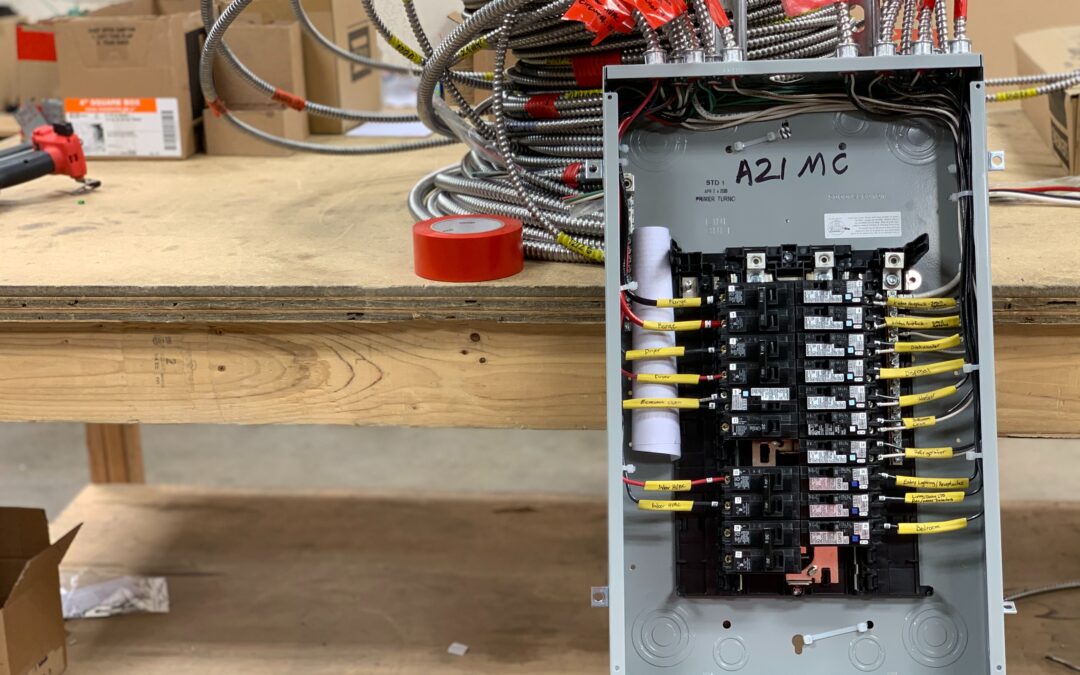Different Electric Panel Types
Electrical panel types vary in size and shape but come in three primary types. Be sure to maintain safety when operating or inspecting your panel. If at any time you are concerned, please contact us for assistance!
The Main Electrical Panel / Breaker Box
A breaker box, electrical panel, breaker panel, main breaker, circuit breaker box, goes by many names but has the same function. It’s the main distribution of electricity through a home or small business and contains circuit breakers that protect the circuits by limiting the amperage to each. A panel without breakers is rare and is known as a main lug panel, which uses a main breaker usually located at or near the power meter.
Inside a common electrical panel, you will find a main breaker (also known as a service disconnect switch), circuit breakers, expansion slots, and hopefully tags or labels. Circuit breakers replaced the old standard of using fuses, which would have to be replaced every time a circuit becomes overloaded. Circuit breakers instead can easily be reset back to the “on” position just like a sideways light switch. Circuits will have a number on the switch which lets you know the amperage at which the breaker will “trip”. Common circuits have amp limits of 15 or 20 for typical household rooms and up to 125 amps for rooms with large appliances such as the kitchen and laundry room.
The total power through a common electrical panel is either 100, 150, or 200 amps. There should be a label on yours to determine its limit. To determine if there is enough total power for an addition (adding another circuit breaker to the breaker box’s expansion area) just add the numbers on the breakers to determine its current maximum load and subtract from the amp limit for the panel itself. This will give you the remaining amperage available for that panel.
Sub-Panels
When multiple circuits are needed to a similar area but is rather far from the main panel, that’s when a sub-panel comes in. It uses one circuit from the main panel and contains its own set of circuit breakers that are limited overall by the amperage of its breaker from the main electrical panel. We find these types of electrical panels in places such as a large, multi-room detached garage.
Sub-panels are also used next to a smaller main breaker box when the breaker box runs out of circuit expansions, but it is better practice to replace an electrical panel with one that is more suited to the circuit requirements of the building. Be sure to not exceed the sub-panel’s amperage limit without upgrading the circuit breaker for its circuit from the main breaker box.
Transfer Switches
Homes with backup generators, solar panels, or battery backups will contain some kind of transfer switch. A transfer switch is an electrical panel that transfers power generated by direct current (DC) into usable alternating current (AC). These panels are often found in areas with rough weather or lots of storms, which makes using a generator a breeze.
Transfer switches can have the ability to automatically switch to generated power when a blackout is detected. Otherwise, there is a switch on the panel that must be operated manually. Depending on the size of the generator or battery backup system, a transfer switch can be just as powerful as the main power to the breaker box, so please use caution to ensure safety.
Home Electrical Panel Upgrade
You may want to upgrade a panel for many reasons which involve a power need greater than your panel can handle. For example, homes with electric heating instead of gas typically have a 200 amp electrical panel, and those replacing a gas furnace with electric will need the additional juice. Run out of available circuits? Sure a sub-panel may get you by, but upgrading the panel is the proper way to go about it. Installing a second kitchen in the basement? That’ll also likely require an electrical panel upgrade.
Older and recalled electrical panels, if still in service, should be upgraded as well. Until about 1980, Federal Pacific electrical service panels were widely used until fatal flaws were discovered. Instead of the breakers tripping when they were supposed to, which caused fires. Also, some open circuit breakers continued to supply power which could cause electrocution. These panels, if found, need to be replaced. Zinsco service panels were used in the 1970s which were recalled due to circuit breakers literally melting to the bus bar (the part on the breaker box that housed the circuit breakers) which prevented them from being tripped when they were supposed to. These panels were re-branded ‘Sylvania” or “GTE-Sylvania” which have the same issue. The two other panel types that are just outdated are called split-bus and fuse box panels. Split-bus panels aren’t necessarily dangerous, but they have some flaws. First, there isn’t a main breaker to kill power to the box. Instead, it uses two banks of circuit breakers hence the “split-bus” name. Fuse box circuits can’t simply be reset without replacing the fuse. These older fuses are simply becoming too expensive to replace to make the unit worth keeping. We’d suggest upgrading these to a modern, safe electrical panel.
Consult A Professional!
Before tackling any home project involving any different electrical panels, please contact us!

